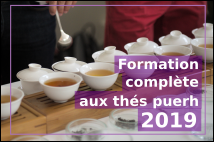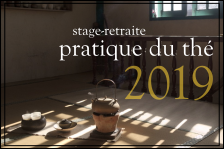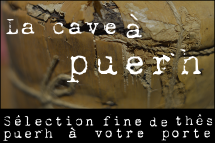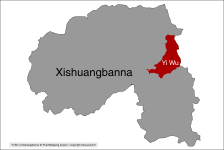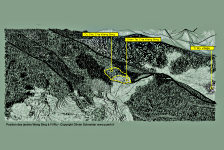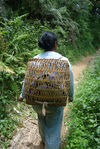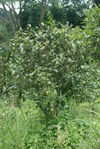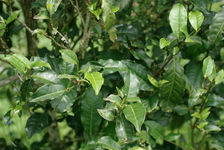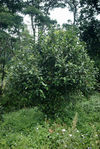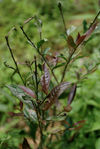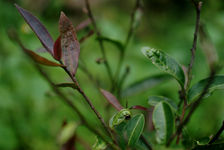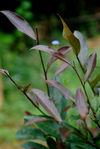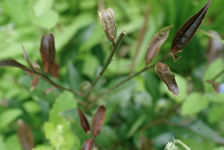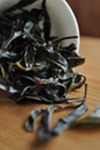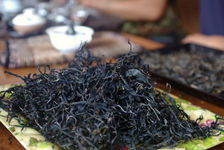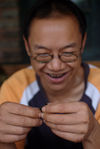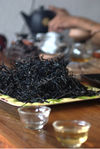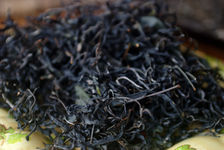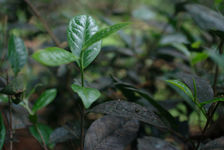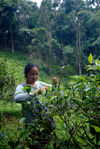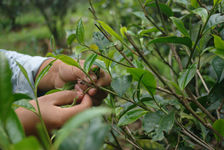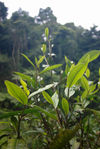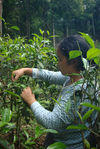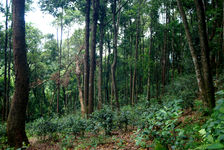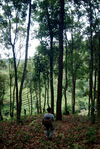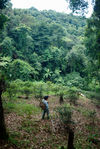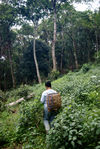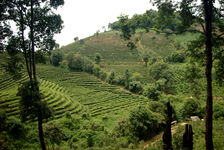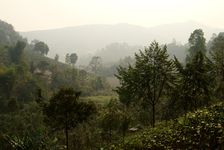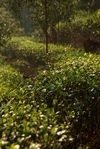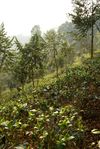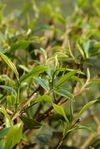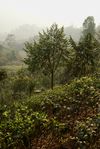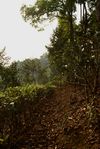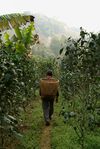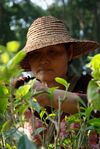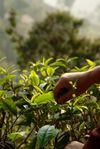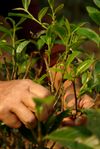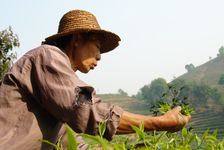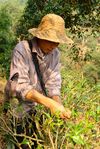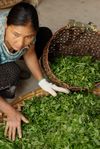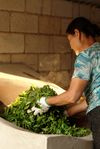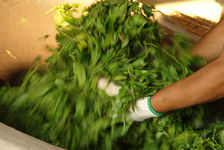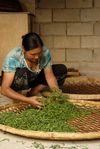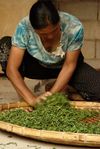 This page is not a real translation but just an automatic translation generated by computer of the original article, written in French language! Its not good... but better than nothing!
This page is not a real translation but just an automatic translation generated by computer of the original article, written in French language! Its not good... but better than nothing!Want to help us do diffuse puerh tea culture in english, by providing a better (or corrected) translation?
Please contact us!

Yi Wu, a mecca of puerh (Pu Er tea) tea
Wu Yi is undoubtedly one of the great names that resound in the ears of the tea lover. Located along the Laotian border in the far east of Xishuangbanna, the group has Yi Wu mountain conditions particularly suitable for growing tea. Bathed in moisture and fog, the slopes of these mountains, which range between 800m and 1800m, and almost entirely above 1000m, offer a perfect setting, whether the quality of the land, the forest cover or climatic conditions that allow the harvesting of tea for nearly 200 days a year.
Different ethnic groups in Yunnan such as the Yao, Miao and thus began to plant tea on the mountain there are over 1000 years ago, and left us some great old gardens.
But it was during the Qing dynasty (644-1911) that Yi Wu returned true in the history of puerh. While the tea puerh (Pu Er tea) becomes Gong Ting, tea for the emperor, and the best puerh (Pu Er tea) teas go along the tea road to the Forbidden City in Beijing, Wu Yi, then called Mansa is recognized among the 6 large tea mountains that are now the main production area of this tea.
Wu Yi and 18th century saw the arrival of a wave of immigration from Han Shiping, attracted by this new object of that trade becomes puerh (Pu Er tea) tea, especially the most prestigious of them, the imperial gong ting these new immigrants were allowed to occur in the region. And thus were born in the first big Wu Yi tea producers puerh (Pu Er tea) as Dong Qing Hao, who will press the first major puerh (Pu Er tea) cakes and mark the beginning of the manufacture of this tea by Han.


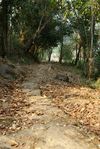
- 1. Old village today Yi Wu (2009)
- 2. Street of the village of Wu Yi
- 3. Remains of the road tea and non horse loins village of Yi Wu
A multitude of historical producers of puerh (Pu Er tea) as Fuyuanchang Hao Hao Chesun or Tongchang Hao follow and establish the decades that followed around the old streets of Yi Wu, producing cakes among the most famous in the history of this tea.
With the advent of communism and large state factories disappear all of these historical producers and Wu Yi falls somewhat into disuse ... into the 90s. The puerh (Pu Er tea) is therefore at the heart of a big phenomenon mainly from Hong Kong and Taiwan where they tore the old stocks of tea, and when prices reach record highs.
It is in this context that puts the spotlight on Taiwan Yi Wu, where after 50 years of interruption we begin to re-press cakes of tea, tea propels it to the top and made the mountain of Wu Yi something almost mythical.
Different villages of the mountain and enjoy the last twenty years a special aura, and continue to be on the forefront especially in Hong Kong and Taiwan. Without the phenomenon is also important in Yunnan, the mountain which recognizes the quality of the land continues to have a solid reputation. We are interested in particular teas for some time in some villages of Yi Wu, Gua Feng Zhai as Mahei or whose prices have gone through the roof in recent years ...
And this is at the heart of this mountain that we will make, and more specifically in the ancient village of Wu Yi, to meet a small producer remarkable history which I am a few years.
Wang, producer family tradition and expertise
Wang Bing is above all the history of the Lee family. From Shi Ping, as the first generation of major tea producers who settled in the heart of the old village in the 18th century Yi Wu, Lee cultivate tea Wu Yi for generations, and are the heirs of tea and knowledge that has been passed from father to son and mother to daughter.
If the ancestors of the family and have known the first hour of glory Yi Wu during the Qing Dynasty, and it has also suffered as the whole of China Cultural Revolution. In these difficult times we really cared Yi Wu tea, but more than what we would put on his plate, and we grew rather enough to feed the family while the tea, abandoned, growing freely in the forest.
But in the 90s with the arrival of the phenomenon puerh (Pu Er tea) and robust demand from Taiwan for tea Wu Yi, the family can focus again and again tea including tea exploit old they have not far from ancient village of Wu Yi They also benefit from the opportunity to plant new gardens more modern (Tai Di), which they later resell part to finance the education of their children.
Meanwhile Wang lives far from Xishuangbanna, in a city newly renamed Ling'er, whose former name was none other than Pu'er tea and puerh (Pu Er tea) which takes its name. Wang, however, is not from a family of tea producers, and it was not until the early 2000s that his destiny will be final with tea. Party in the Xisuangbanna to find work he spent two years working in a tea producer in the region, which will send one day to buy Wu Yi of Maocha, puerh (Pu Er tea) loose tea in its raw form ...
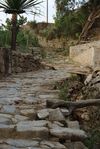
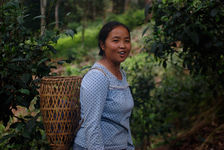
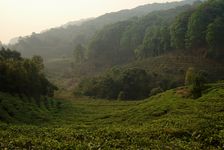
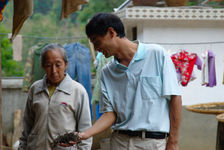
- 1. Street of the village of Wu Yi
- 2. Ms. Lee in the tea gardens of the family
- 3. Tea Garden near the village of Wu Yi
- 4. Wang Bing in observing a Maocha a village in Yi Wu
Buy Maocha in Yi Wu is, even today, not an easy task. Many families refuse to sell their leaves, especially the first comer, preferring in general focus on the likelihood of a rise in tea (which in Yi Wu regularly skyrocketed from one week to the next) rather than separate too quickly harvest days.
Thus Lee's daughter saw one morning the young Wang knock on his door to ask if she had tea for sale. She also repackage dry: it has nothing to sell here. But if Wang has outstanding quality is his ability to get what he wants. I do not even account the number of times I've seen in recent years Wang out of a farm Wu Yi smile on her lips a big bag of Maocha hand, after having been received yet few handfuls of minutes before by "there was no tea" or "we do not sell tea" ...
Wang and often revert portal Lee to inquire about any possibility of buying tea family, yet despite the eternal same response daughter Lee. I do not know if the tea will long remain the primary motivation for this game, which will last a little while before finally obtains Wang ... not just the tea family but Lee hand of their daughter.
Thus Wang Yi Wu to relocate, and install the side of his wife in the house of Lee, where they give birth to a boy and bringing a third generation in the family home. Now immersed in the heart of Tea Wu Yi, Wang quickly leave to resume his work and develop the family business. He will learn to press and the village puerh (Pu Er tea) cakes, then build the walls of the house a small workshop to press its own pancakes while the family hitherto merely Maocha sell wholesale and deposit the name Wang Bing to be able to market these cakes.
In the traditional small farm where the family lives of Wang Bing, tea is ubiquitous today. We do not live as we live tea tea, grandparents continue throughout the day to harvest the trees of the family he will work in the evening fresh leaves, the couple Wang and his wife who will press the patties , passing through the beautiful sisters and brothers-in Wang who also cultivate tea village until last that little top of its 4 years already demanding his cup of tea!
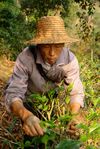
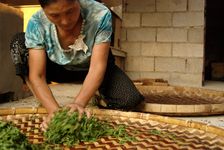
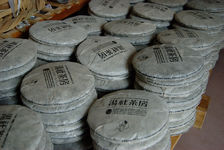
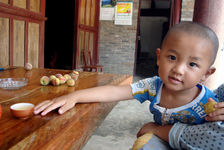
- 1. Mr. Lee harvesting tea leaves
- 2. Ms. Lee working the tea leaves
- 3. tea cakes freshly squeezed and packaged
- 4. The son of Wang Bing to 4 years (2009)
But what brand first when you arrive in this house is welcoming and relaxed atmosphere that prevails there. Placed on the side of a street of old stone of the ancient village of Wu Yi, some meters away from the remnants of the legendary studio Fuyuanchang Hao, there is something here that inspires immediate calm, tranquility and quality of life. A wood fire over which leaves the day gradually offload their actions under controlled humidity and posed for Ms. Lee, a few cups of tea in which délassent the last leaves that Wang worked carefully taste, a delectable aroma escaping the kitchen and announced other gustatory pleasure, off the stifled cry in the mist of a cockerel or the barking of a dog ... Here we breathe, and live in peace and serenity.
The madness of the 90s, and then the years 2003-2007 has passed and left behind some prosperity. Despite speculation about the Tea Wu Yi and capricious prices, demand and price of this tea are particularly high and draws primarily from Wang to quality work, old, and some peace life. As in many families Yi Wu, if we continue to go raking leaves and produce daily from Mao Cha, because it is necessary to balance the plantations, there is now urging the cakes to order. Customers know the family, gardens, place orders and pay in advance, usually before the leaves are harvested.
There are of course times when the activity is more intense, especially in the spring but still small productions. Wang will explain elsewhere if their prices were a little more expensive than other families of Yi Wu, it was precisely because they were all in small quantities by hand, emphasizing above all the quality and it required a lot of work.
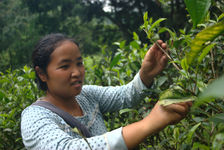
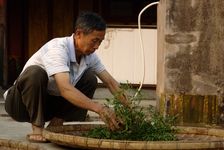
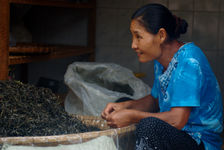

- 1.Xiao Lee picking tea leaves
- 2. Drying the leaves in the sun
- 3. Tri tea leaves
- 4. Pressing and packaging of cakes at home
The leaves are harvested during the day and worked daily at home during the evening spent in one of two large wok heated over a wood fire to lose water, carefully hand-rolled on mats woven bamboo and then spread on the roof of the house where they take their final color under the sun the next day. It will then be sorted, one by one, to keep only the best leaves before being pressed in the hand by Wang under heavy stones then be packed.
Thus prefers to produce less Wang, and focus both the product quality as the quality of life of those who are behind, rather than produce more cheaply. Even as the days are very busy during the spring, starting with the sun and often end past midnight when the last leaves have summers spread over the roof to dry ...
But if the care work sheets and compression cakes Wang is undeniable that makes the difference and quality of these teas begins much earlier, in the heart of the gardens growing trees of the family.
gardens among the finest Wu Yi
Wu Yi village is located south of the mountain bearing his name at 1320m altitude. Around the village have quite a few old trees, in comparison for example Mahei village, renowned today, 5km away. If these two villages do not have a particularly high altitude they are both built on the side of higher peaks than the general Yi Wu, and once passed the 1400m offer particularly favorable conditions for the development of tea quality.
This is particularly the case of the small peak just south of the village of Wu Yi, the high part, surrounded by haze is covered with forest, where the most beautiful gardens Wang undoubtedly among the best placed in the village. Leaving the farm, the old stones that pave the village of Wu Yi, ancient remains of the road tea and horses, quickly leave the place to the ground with a narrow path that forces its way into the heart of a lush .
Before reaching the hill and the old gardens of the family, the path wanders between young tea plants, trees planted by the previous family just a few years ago. Here and there appear tea in the landscape. Leafy greens and they seem to have grown like mushrooms on the thick carpet of grass covers the ground. We immediately notice the richness of the surrounding vegetation and respectable distance between the tea trees.
Although young trees it feels like an old garden, where tea trees, scattered here and there shared space with the surrounding nature.
purple buds amidst the greenery
Between tea attentive observer will not fail to notice the little purple leaves and slender particularly coming contrast the bright green tea.
Planted in 2006, at the peak of the boom puerh (Pu Er tea) 2000s, it is youth plans Zi Juan (紫娟), a new cultivar of tea purple and very popular particularly rich in flavonoids and anthocyanin. Isolated in 1986 by the Centre for Research on Yunnan tea, this cultivar has begun to make its appearance in the tea gardens in the 2000s and is still hard to find on the market.
Taking advantage of the high price of tea Wu Yi, the family will invest in this cultivar in 2006 and planted a number of feet, despite the particularly high price seeds Zi Juan, over RMB 1 seed in 2006. I must say that the price of tea purple is also very high, exceeding 1000 RMB () per kilogram in 2007, and can justify the investment.
I was with Wang in 2009 when the first harvest of these trees has taken place, yet extremely limited production which was at that time on a tray. A year later only a few small kilograms were pressed, which reads one of the first cakes.
 Chargement du thé...
Chargement du thé...Three years later, the trees are still in their adolescence and the annual production is minimal. Profile aromatic teas that are very similar result, but with a small gain in strength and endurance. Here is the latest leaves (2012) produced by these trees.
 Chargement du thé...
Chargement du thé...Now leave teas purple to continue the tour of the gardens Wang continuing our progress towards the mountain. For this we travel between the first tea where a path is gradually taking shape despite the thick carpet of grass covers the ground. This trail, which is probably practiced by a few families, is a thin line of land in the greenness of the landscape, aspen, trying to follow the terrain while the nascent we approach the mountain.
the hearts of tea older forest
After climbing some time between tea and meadows the trail suddenly engulfed by vegetation and plunges us into darkness dim forest, where it is a very different landscape that awaits us.
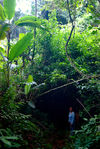
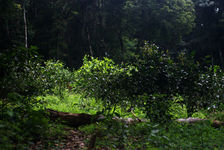
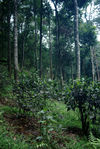
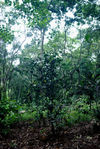
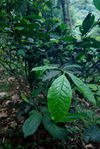
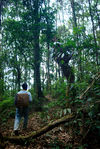
- 1. Suddenly the trail into the heart of the forest
- 2. Young tea in the shade of large trees
- 3. Garden oeur the former Forest
- 4. Garden in the heart of the old Forest
- 5. Garden in the heart of old forest
- 6. Garden oeur the former Forest
It is in this forested area, which more than 1400m above the village of Wu Yi, which are among the most fabulous gardens Wu Yi Tea The tea trees are grown in the heart of a environment of great natural wealth, and in the shade of majestic trees.
If Lu Yu had already noticed there are over 1000 years ago that the tea took advantage of the shade of larger trees, and therefore constituted a forest habitat for the tea, such gardens in the heart forests are rare today where the tendency is to cut down trees in order to maximize exposure and increase production.
Furthermore shading such a forest favors the presence of fog, especially in that region and appreciated the tea, but also offers a natural environment with trees of great wealth. Including soil, soft, wet and covered with a thick layer of leaf litter and humus is of incomparable wealth. The natural balance of the forest when his controls pests without any human intervention is required.
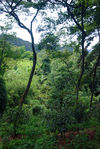
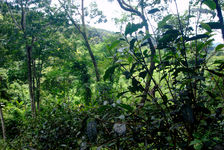
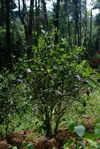
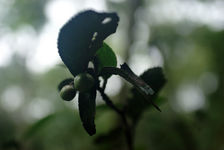
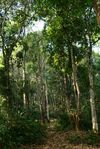
- 1. former Garden in the heart of the forest
- 2. Garden in the heart of old forest
- 5. old garden in the heart of the forest
The tea is no surprise to the height of the frame in which they operate. Round and thick, they sparkle bright green in the shadow of the forest. Of great vitality they brandish their thin branches in all directions like an attempt to reach the trees that house, about 15 feet above them.
As is often the case in Wu Yi can easily misunderstand the age of the tea if you just quickly look of their trunks, and think that these trees have only a few decades. There is in fact that the population of Wu Yi who has suffered from the Cultural Revolution but also tea trees which, while were several meters high summers have cut the base to push it with a scale faster and easier to harvest.
If the visible part of the tree and did a few decades, its roots are much older they, and continue to feed the tree of their own strength. Two things indeed explain the uniqueness of ancient trees facing young plantations. There is firstly the breadth and depth of the roots, which allows mature trees to get the best ground that houses a Chinese saying about this teaches us that a tree is as large underground at its surface.
But older trees also differ in their constitution, and substances produced by tea tree change with the age of the tree. Old trees, whether or not cut summers produce including a number of secondary metabolites, these substances are not directly necessary for the growth of the tree, and are largely responsible for the character and taste of the beneficial properties old tea teas. And this is what makes the difference between a particular tree planted 50 years ago, and a tree whose trunk was cut 50 years ago, which sometimes visually closer in appearance, but will differ once in the cup ...
So taste a cake produced exclusively with the leaves in spring 2012 from the garden.
 Chargement du thé...
Chargement du thé...
But, contrary to popular belief we hear too often the quality is not the preserve of old trees. As beyond the scope of their roots, their strength and their unique constitution, we often forget that what also makes the quality of old trees today lies in their past, and more specifically in the way they been planted and maintained.
So if the tea plantations from intensive contemporary is often of poor quality, it's probably much more to be attributed to the way these trees are maintained and (over) exploited at a young age of these trees, gardens and ecological Wang Bing are the best example.
From where we are it takes to reach the garden dodging the old tea in the direction of the valley until you reach the edge of the forest. In the distance we see between the trees framed Tai Di conventional crops such as terraces that are widespread in recent years and growing on the opposite flank. But it is a completely different panorama awaits us a few meters down ...
ecological gardens of rare beauty
Just below the forest, is one of the most beautiful gardens in the family. Planted some twenty years by-laws of Wang Bing, so it is relatively young tree is called in the family "Tai Su," compared to old trees that we have seen .
The landscape that we offer is however quite different from that which is generally understood by Tai Sun, or modern cultures of tea: the mountain peeled, striated by regular lines of trees teas reduced the size small shrubs well trimmed. In contrast to this, the garden, carefully maintained by grandparents Lee reflects more the first image that comes to mind when you hear the word "garden".
Trees despite their young age like trees with a trunk and long thick branches that extend towards the sky and silhouettes which are not without thinking of ancient trees that we have seen. The soil is rich and supple with a thick carpet of dead leaves. Here and there grow different species of trees and plants that punctuate the landscape and offer their shade to tea. All bathed in moisture and freshness of a little morning mist, offers the visitor a bucolic landscape resplendent.
Few years ago you could even cross in the garden hens frolicking freely between the tea. The Lee family, like all farms Yi Wu had time animals, chickens, rooster, pig at home, but to ensure better hygiene in the production of tea, they are separated against the heart , with the exception of hens that have been relocated in the middle of tea. Unfortunately things have changed even in the depths of the mountains, and they end up getting robbed their hens, who this year left their place ... bees!
Not satisfied with the disappearance of their chickens, grandparents Lee are indeed begin to Beekeeping and built a multitude of traditional hives buzzing here and there between tea and while adding to the richness of the framework occur during the flowering tea honey tea promising.
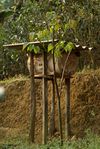
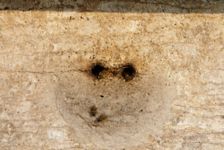
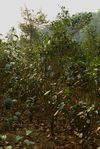
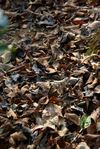
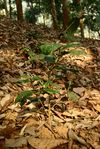
- 1. Hive in the tea garden of Wang
- 3. Tea Tree green
- 4. Ground covered with fallen leaves
- 5. Seedling emerging natural ground
The difference between such an ecological garden and a conventional Tai Di obvious, and is visible even on an aerial! Where the terrace cultivation rid generally mount and balance all she had to live, to be developed as a cancer maintained in regular stripes, a garden like this one grows with its environment. Larger trees were especially thick and spaced, have a network of more branches deployed, but also more mature leaves, large, that give the tree its energy. Between tea there is life, larger trees that scattered here and there to offer shade tea plants, small shrubs which shelter a lifetime animal and repel harmful parasites, and a cycle of natural decomposition that nourishes and renews the soil.
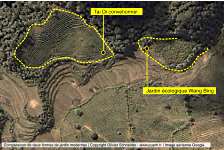
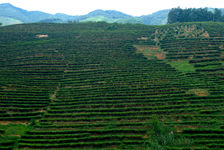
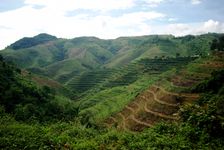
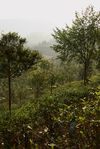
- 1. The ecological garden Wang from the sky
- 3. Construction of a conventional nouveu Tai Yi Wu Di
- 4. Wang Ecological Garden
This type of garden reflects to me the concept of ecological garden or Shen Tai Chinese. Where a garden BIO sometimes simply ban the use of chemical fertilizers and pesticides, sometimes replacing them with their equivalent biological, ecological gardens such turn are deeply in harmony with the surrounding nature and remind us of the gardens old, sometimes multi-old, we have left previous generations. Of course this notion of Shen Tai is relative, and so for me it should reflect such environmental practices really listening environment, a number of tea growers consider a terrace Tai Di-intensive and operated as soon as the green trees are not sprayed with chemicals ...
We will not be surprised by the high quality teas that can achieve such young trees planted and maintained with care and respect ... Such a great taste cake pressed by Wang and precisely from the ecological garden we have visited. Small production pressed my request it is exclusively the leaves of the garden, harvested and processed with great care during the first days of spring 2012 by the grandparents of the family.
 Chargement du thé...
Chargement du thé...
comparatif
Wang Bing Gu Shu Cha vs 2012. Wang Shen Tai Cha 2012
Both liquor are also very nearby, especially the first infusion. After a few infusions they deviate slightly, the liquor Gu Shu appear as slightly darker and copper.
To taste it is clearly in the same vein, and these teas are undoubtedly the same type of tree and the same soil.
The Gu Shu appears, however, from the first sip to be very much more intense and deep, with a better propensity to spread to the throat and nasal cavity. This difference will be evident throughout the tasting. Shen Tai which however is excellent and does not lack intensity taken independently seems light and almost tasted bland side by side with Gu Shu!
While sharing a similar flavor profile, the Gu Shu has a far more pronounced bitterness, especially in the throat, which gives it a much more open and gross dry there or Shen Tai is more soft and round.
The panorama taste Gu Shu appears and wider, including strength and lightness, or there seems to Tai Shen cut all the raw dimension and bitter to keep just enough to support the roundness and softness typical of Yi Wu
But what finally assign the outstanding quality of these teas? As we have seen we can raise the quality of the soil, excellent position gardens Wang and the quality of the gardens themselves and the beauty of the trees that grow there. But behind the beauty of these gardens is above all a unique know-how, which is undoubtedly the difference of these teas and well unfortunately has a strong tendency to disappear. We forget too often when in fact the climax of tea tea older than the age of the tea behind it is also a reflection of past practices ...
last heirs of expertise that is lost
Grandparents of the Wang family work indeed "old" as the greatest world does today. Raised with the day they leave in the morning to the tea gardens, vegetable chewable thrown into the basket of woven bamboo that will collect the tea leaves for the day.
It is in these tea gardens they spend the whole day, a small wooden shack between tea from time to time to take shelter from the sun, drinking a cup of tea or chew a piece of vegetable . The rest of the time they spend face to face with the tea.
And this is where the difference is, starting with the choice of leaves you will pick. Tea tree is a leafy colors and sizes, but every leaf has a function, purpose, and leaves the choice of picking will be crucial not only for the flavor of the tea, but also for tree health and quality of the sheets to come.
Pick the leaves with antique and respect is not always cut all the green shoots as it often until they repel just a few weeks later. This is not to follow the latest standards established arbitrarily by not picking for example one or two leaves for a bud.
Not the true traditional harvesting as practiced since ancient times is to understand the life of the tree and have a keen sense of observation to cut the rod to the right place to extract the mutually satisfy the tree and the palace. Every detail has its importance, the position of the leaf on the branch, its color, shape and position of other leaves nearby. Even exactly where you sectionnera branch is important, and should be avoided for example cutting too close to the sheet to allow sections of upright branches towards the sky to promote hydration of the tree.
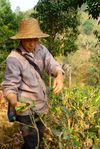
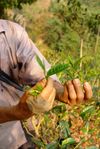
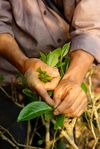
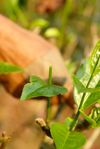
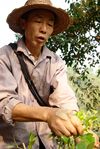
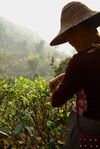
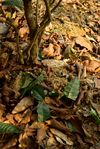
- 1. Picking traditional fine
- 2. Example of leaves will be picked
- 3. Location or stem should be cut
- 5. Mr. Lee picking leaves tea
- 6. Ms. Lee picking tea leaves
- 7. Leaves removed which will be left at the foot of the tree
More true function of such a gathering is not only to extract the leaves end up in our cups, it is above all to maintain the tree in the abandoning of leaves that are not beneficial to him. These two tasks are performed simultaneously: that while the expert hands of grandparents Lee roam the trees in search of leaves that end up in their baskets, each branch is scanned with a watchful eye and all the leaves whose tree n does not need are systematically removed. They end at the foot of the tree where they gradually degrade and enrich the soil.
Now this is a real knowledge of great complexity. If already keep track leaves is not clear about the need to cut requires a lot of knowledge. There are in fact a multitude of reasons why a particular sheet will be better at the foot of the tree on the branch. Already complex for young trees, the daily maintenance of trees is more for old tea, where there are more leaves to remove.
The result of such collection and maintenance of the old trees is undeniable. Not only visible when facing the trees, it is also particularly noticeable when we taste the fruit teas depth and a remarkable intensity. Such practices have a cost. Not only it requires more knowledge, but also requires a lot of time and work. And grandparents of the Wang family produce in their garden with their saplings almost two times less than that produced by a conventional Di Tai same area, although more work.
These ancient practices and already have almost disappeared. While some seniors continue to maintain their garden so the younger generation has not taken over and is moving towards a less fine and more profitable. Many young people also gather more leaves themselves, preferring to pay for this one cheap labor, often from different ethnic groups in the region.
It is unfortunately the case of Wang and his wife, in whose eyes the way of working grandparents came from another time, and they will not provide inheritance. If a few years ago Lee Xiao, Wang's wife already picked a less fine than her parents, she has now completely stopped picking leaves, for as we will see focus on the selection and sale of tea, Wang and the couple now paying the workforce to care for their own gardens.
However, this situation is not unique to the family of Wang Bing and found in almost all the houses in Yi Wu and elsewhere, where we are moving to a more modern and ancestral knowledge that has already virtually disappeared.
There is indeed not a high enough demand for such high quality products that would justify the poor performance of these practices. Well if there are slight differences in price from one producer to another tea Wu Yi is primarily listed. Variable from one village to another and sometimes from one week to another, the price of all producers in a given village in a given period following the coast of the village and are substantially the same, and few will be willing to pay twice the current price for a tea picked and worked in the former. This is also why the new generation is moving towards trade often leaves that to their crop, which provides more opportunities ...
From harvest trade
Since the opening of the tea market in the late 90s the farmers who own the tea trees are in various situations against the sale of their productions. In most cases they are involved in the maintenance and harvesting of trees and leaves work at home to produce Maocha. This is puerh (Pu Er tea) bulk then sell them wholesale to others, who will be responsible for their share of press these teas and commercialization. In some cases the farmer does not even work sheets and sells fresh leaves just harvested a cooperative or private clients, particularly in the region where the bulk of Mengku leaves are sold fresh.
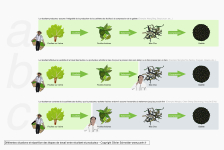
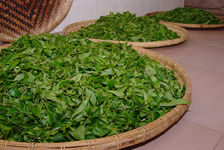
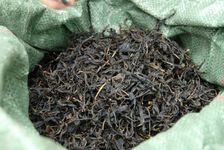
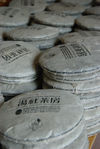
- 1. Different situations and distribution of work steps between harvesting and producer
- 2. Leaves freshly harvested Yi Wu
- 3. Bag Maocha to Yi Wu
- 4. cakes freshly squeezed by Wang for tea house
It is much rarer than against the grower himself his press cakes, Yi Wu doing here above exception. The phenomenon came from Taiwan in the 90s around the puerh (Pu Er tea) tea, Wu Yi is powered by the Taiwanese who are a symbol and submit a few embers on the historical past of the village of Wu Yi is a former research scholar then, author and calligrapher, to unearth the knowledge lost during the Communist era and start pressing puerh (Pu Er tea) cakes directly to the village of Yi Wu
Gradually the thing snowballed and it takes pressing patties in artisanal properties Wu Yi Thus, in arriving at the farm of Lee, Wang established a small workshop to press and sell the name of the tea family, who previously produced only the Maocha. While that parents continue to work and collect the tea leaves, assisted when necessary by their daughter, Wang is responsible for taste teas, in press cakes, promote and negotiate with clients .
But with the refinement of land that has been observed for some time, customers are looking for more tea from a particular village. There or there's 10 years is merely tea Mount Wu Yi, is now seeking Mahei tea, Luo Shui Dong or Gua Feng Zhai.
Given the increased demand not only for its own tea for tea but also the neighboring villages, Wang and begin to press for its customers to order teas from the surrounding villages, which he knows teas and producers.
Gradually this activity is becoming increasingly important, we trust Wang for his seriousness, his ability to choose the best leaves and craft skills in pressing patties. In 2010 Wang pass the driver's license and buy a car that allows it to more easily and frequently in the neighboring villages to do the sourcing Maocha.
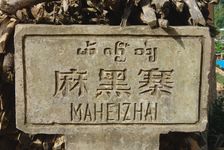
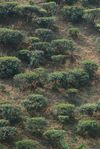
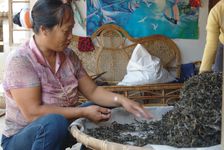
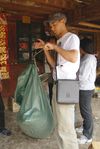
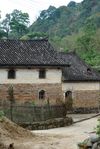
- 1. Mahei one of the most sought after town of Yi Wu
- 2. Trees Mahei tea
- 3. Leaves during sorting Mahei
- 4. Wang Bing currently Maocha to buy Mahei a small producer
- 5. Luo Shui Dong, another village famous Yi Wu
Its strong point is its proximity and knowledge of the surrounding villages. Wang and buy only in villages close to the village of Wu Yi, where it is known that he knows almost every family and where he can go every day if we need to test the waters and quality control . This space extends around the village and Yi Wu shu qi Da up north, Man Luo cin east and south Lao Zhai Pu. For Wang is essential and it is quite impossible to make a real quality work with leaves from more remote villages such as Gua Feng Zhai east or north of the villages of Yi Wu .
Sourcer of Maocha is indeed a long process, especially in a region that also sought Yi Wu the early days of spring every day must be aware of the thrust of the first buds, whose arrival is varies from one village to another, even from one family to another, and do not hesitate to miles every day to be sure you are in the right place at the right time. But, Wang Bing is very well placed to know, it is not because the tea is where it is for sale, and many prefer to wait any prices before selling their first leaves, forcing to overflow with flexibility in order to acquire the leaves are looking a decent price.
For years the price of Yi Wu are capricious, changeable as the wind, and nobody can predict the price of tomorrow or next week. On everyone's lips, whatever the street or the village are the same questions when producers intersect: is that tea has blossomed here? And what is the price today? No need for internet, telephone or announcement that prices rise suddenly, sometimes from just two or three families, and the news spread like wildfire from house to house leading to a general increase prices, which makes the climate Yi Wu particularly surreal, especially in early spring.
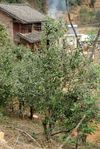
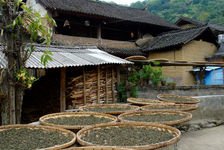
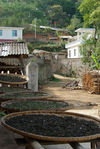
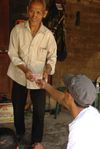
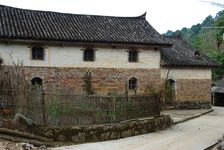
- 1. Tea Tree Gao Shan, Wu Yi
- 2. Tea leaves drying Luo Shui Dong
- 3. Tea leaves drying Mahei
- 4. Wang Bing buying a few sheets of Maocha to Mahei
- 5. Luo Shui Dong Village
It is in this atmosphere was born the next tea that we enjoy in the first days of March 2012, while the Yunnan undergoing a new wave of drought. While virtually no ancient tree had not produced any bud around the village of Wu Yi, where we had not seen a drop of rain for months, the first buds have appeared on the ancient trees of Mahei a villages most sought Yi Wu .. Such sheets that defy drought, sips nectar that is progressively concentrated during the winter, have a unique intensity and depth and makes them particularly desirable.
A few days later the first rain of the season, was on everyone's lips for weeks eventually fall break from the drought and relax the atmosphere that prevailed among producers ... This unusual cake is a 2 kg micro production, which has been pressed by Wang at my request from these few leaves Mahei pushed before the first rain of the year, and carries it somehow this magical moment. From a family that produces some of the best tea Mahei these few cakes are probably one of the best productions of 2012 Yi Wu ..
 Chargement du thé...
Chargement du thé...Other products sourced by Wang are quite remarkable and still require more work. This is particularly the case of Zi Cha Yo, local tea purple Wu Yi, Wang which has produced in recent years several cakes particularly interesting and rich.
Yo Zi Cha, authentic violet tea Wu Yi
Teas violet or purple tea, derive their color and unique aromas of a natural mutation and rare tea. Violets on the tree, the leaves produce a Maocha almost black, to become green in the pot, and give rise to a dense liquid, deep and particularly aromatic.
Rich in anthocyanin, which has continued to demonstrate benefits in recent years, these teas are especially prized purple, summers were rooted cuttings to produce gardens full purples, violets and new cultivar have recently been isolated as Zi Juan, also cultivated Wang Bing, which we discussed earlier.
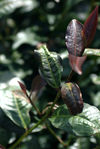
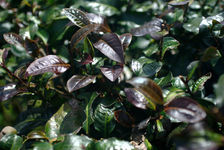
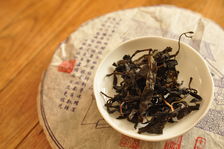
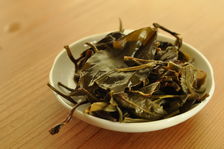
- 1. Natural purple leaves on a tree Wu Yi
- 2. natural purple leaves on a tree Wu Yi
- 3. Sheets worked violets (Zi Cha Yo Wang 2012)
- 4. purple leaves infused (Yo Cha Zi Wang 2012)
But the richest purple teas originate undoubtedly older trees from natural mutations. Such tea exist particularly in the region of Wu Yi, where they are called Yo Cha tea fat in French, because of the shiny side of their leaves. But these are rare tea, and a family has no more than a handful war, which is not enough to make a real production ...
But one day Professor Wang, a publisher of Kunming, also author of several books on puerh (Pu Er tea) and involved in the production and sale of tea upscale tastes in Wang Bing few purple leaves probably from the garden of his beautiful sister. Particularly interested in tea, Professor Wang has already producing different puerh (Pu Er tea) purple, Wang ask the possibility of sourcing enough to make a real production, giving birth to the first Jing Zi (or violet) Wang Bing.
 Chargement du thé...
Chargement du thé...
But to produce such a natural purple tea must be for weeks to turn a multitude of families in different villages of Yi Wu, for each time does bring some ridiculous little bags Maocha, which will then be tasted finely sorted and assembled, which is a daunting task. Professor Wang to sign this contract with Wang, who produce this tea until 2010, where disagreements will end this collaboration.
Here is a recent cakes Zi Jing produced in its spring.
 Chargement du thé...
Chargement du thé...
comparatif
Wang Zi Jing vs 2008. Wang Zi Jing 2009
A parallel tasting leaves appear, however a clear superiority of the 2009 vintage, at least in the cakes that I have, which seem to come from a spring harvest (where the 2008 vintage was an autumn harvest).
The tea liquor is thus more copper in 2008, purer and brighter than that of the previous year. The smell of the leaves is also more intense for the vintage 2009.
It is the same flavor, with aromas and further more generous in 2009 than in 2008. If it is quite similar in the mouth is in the nasal cavity that the difference is still more feel with touches more pronounced for the cake in 2009.
If one is in the same vein as the 2008 vintage seems to face his rival as a little off, or the cake there is more exuberant in 2009.
These differences are likely to first put on the account of the harvest season, fall against the spring, but also the greatest master Wang acquired over the years of this production difficult.
In 2010 I did re-pressing a very limited series of this purple tea by Wang Bing, a friend French designer, Nikosan in 200g cakes, repeating the same recipe from a fall harvest. This production is the first to bear the real name of the local tea, Cha Zi Yo, tea fat purple inspired side shiny purple tea leaves on the shaft, but whose name is never used on packaging to avoid using the word "fat" little seller ...
 Chargement du thé...
Chargement du thé...Two years later, a new special series of this tea purple, made exclusively from picking spring is pressed by Wang at my request. Also known as Zi Cha Yo, it comes accompanied by a series of high-end 3 other cakes 2012 producer.
 Chargement du thé...
Chargement du thé...
comparatif
Wang Zi Jing vs 2009. Wang Zi Bing Cha Yo 2012
Taste the character of these two teas clearly share something different while remaining. Yo La Zi Cha 2012 is first far more intense, with much more presence and intensity.
But besides the difference in intensity the character of these two discs are unique. The 2009 Zi Jing is not only lighter but also more pure, focused, precise. Yo La Zi Cha 2012 for his part has much more flavor, more variety of sensations that gives both more wealth but less finesse and precision.
It is also marked by the more raw mat, masculine and robust Zi Cha Yo, completely absent from the 2009 Zi Jing expressed smooth and velvety.
This Zi Jing 2009 seems initially less rich, can be from autumn leaves, but has been worked by 3 years of maturation, and that the 2012 appears to be very young and full of flavor ...
Result of years of work on the violet tea Wu Yi, the new album from Yo Cha Zi door it really the work of Wang, his knowledge of the land and the families of the region, its requirement in the selection and sorting leaves, but also excellence in craftsmanship compression patties.
Sourcing as a tea of this quality is more difficult than we can believe. It first as there's we saw the whims of tea prices, the difficulty of purchasing some leaves, but above all there is the question of quality.
Contrary to what some people think the land is not only the quality of the tea. The Maocha is produced daily, the dropper with a number of variations. The first weather affects permanently the quality of production, and it is necessary to monitor the state of the sky every day if you want to predict the quality of tea the next day ...
But the quality of work sheets also greatly lack of stability in many small producers, especially in the spring when the volumes are large, leaves work nights lengthen and the quality and consistency of the contents of Maocha bag is not given, and not obvious to estimate ... especially when you have no time to taste the tea!
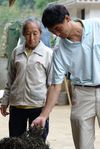
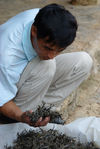
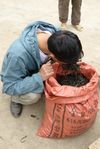
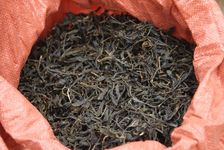
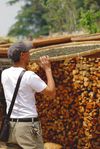

- 1. Wang Bing in the process of sourcing the Maocha to Yi Wu
- 5. Wang Bing currently sourcing of Maocha to Yi Wu
- 6. Wang Bing in the process of sourcing the Maocha to Yi Wu
As in Yi Wu, as in many campaigns, it does not taste the Maocha when purchased from the producer, despite the high prices of these teas. Far from what Westerners are accustomed, trade fairs, markets in tea shops in the city, where you can leisurely enjoy different teas in different configurations before buying the tea leaves in Wu Yi campaigns are generally considered dry, which requires much more skill and habit.
In the first place it is with eyes that can judge a Maocha, leaf quality, the way they have it worked summers. With enough knowledge and practice in the work leaves many things to read on the sheet, and in particular the actions that have worked and defects in this work. Rolling too much or too tight, too low temperature during the Qing Sha or otherwise leaves damaged by too much heat or not proper movement, every gesture is engraved into the sheet.
Because what you are buying before any tea leaves, and what we judge is not a flavor but the quality of Maocha, whose flavor tea that will eventually result. Anyone who knows the one hand terroir where the leaves come, taste and character of teas that result, and the other is able to judge the quality of the leaves and their work can estimate without having to taste tea its character and its rich liquor.
Then of course comes the smell, which escapes from the bag or sheets Maocha drying. Sometimes you can also chew a dry leaf to have a more precise idea of its flavor, and how they take place.
But we must also be constantly attentive to every detail. Is the Maocha, which may have been produced over several days, is homogeneous in the bag or is that the bottom leaves differ from those that we currently observe? What is the exact proportion of huang pian, leaves the low value that we remove during sorting and thus the proportion in the bag can quickly have a strong influence on the actual cost of tea?
Of course this requires a lot of knowledge and practice, and even after several years in the business always happens that you discover once before the tea table tea the last purchased was not up to what was expected, and so we can not do anything with it if you search to produce a quality tea. Like many businesses working in the tea requires indeed to accept the loss, and it is better to throw it away if you want to achieve a quality product and that it aspires to a certain perfection.
A requirement and a constant search for perfection
For if there is one thing that characterizes the Wang family, is the requirement in each other's work and a constant search for perfection. We have already seen the requirement grandparents when to harvest the leaves, but it found that in each step of the tree to the cake.
The work sheet is done by including grandparents with the same search quality harvest. Everything is constantly working to improve the quality of tea products. The wok summers recently moved outside to allow for better ventilation when Sha Qing, chimneys venting wood smoke in the distance and avoiding wet leaves, particularly sensitive, can be stained by smoke. It is during this stage that many puerh (Pu Er tea) take this typical smell of smoke, usually due to poorly designed equipment or misused.
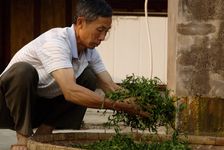
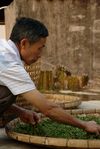
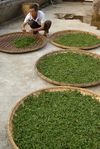
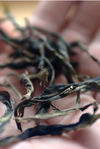
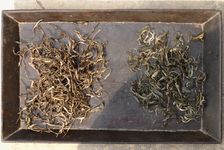
- 1. Drying of leaves
- 3. Drying sheets
- 4. Dry leaves
- 5. Two Maocha Wang Bing, autumn (left) and spring ( right)
Each step is carefully controlled and the temperature of the fire, the smell of leaves during the Qing Sha, the form that gave them Rou Cha, their conditions of drying in the sun or in the greenhouse that has been re-built CETS effect until drastic sorting leaves.
Because what makes the final quality of tea is always the sort that if it is carried out is limited to roughly remove the leaves worked poorly, or is made finer to keep only the leaves according to its quality standards. Usually it is spread to the Maocha an area of braided bamboo, we return here and the leaves are then removed packages which seems inappropriate before throwing the remaining leaves into a bag and repeat the operation with new leaves.
If it's quick and you can always pass a few leaves lost in the middle of Maocha and Mrs. Lee prefers this one again any other method of work, but much longer to perfect sorting. Spread over an area of braided bamboo, on which we will also take care of adding a plastic film, the leaves are taken one by one by hand and observed independently. The leaves will be retained thrown into a first bag, while the others will be thrown into a second bag. We imagine of course work that may be involved to take one by one each leaf bag Maocha and choose whether it may or may not end up in the cake ... but eventually the leaves they have not already picked one by one?
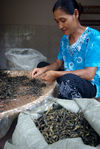
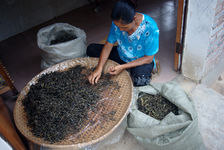
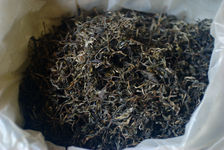
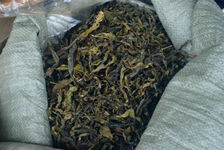
- 1. Sorting sheets one by one
- 2. A basket for the sheets to keep the other for yellow leaves
- 3. Leaves used
- 4. Yellow leaves
Whether Yi Wu or elsewhere, these leaves removed during sorting, generally too old (too large) or poorly worked ie who did not take the typical form of a twisted sheet puerh, are also thrown but not consumed throughout the day by the locals. Producers do indeed drink rarely leaves high quality, especially in areas as expensive as Wu Yi, and more generally consume these leaves called Huang Pian (yellow leaves) or Lao Ye (old leaves). Infused long enough, they produce sweet aromas, fresh and lemony. Different ethnic groups in Yunnan also do not drink the tea almost exclusively in this form.
The price of Huang Lao Ye Pian or being much lower than the price of ordinary leaves, tea is consumed mostly by locals and found rarely on the market. However when the price reaches some local prices such as Yi Wu, Huang Pian old trees are found more expensive than Maocha some regions therefore have a true market value, and are sometimes pressed as cakes! This is particularly the case with this cake produced by Wang Bing in 2012 from the Lao Ye their ancient trees.
 Chargement du thé...
Chargement du thé...
This attention and seriousness found in the work of grandparents harvest sorting sheets is also reflected perfectly in the way Wang and his wife choose and buy the tea leaves. Quality has a price, the workplace, and Wang and his wife do not hesitate to invest fully in the selection and compression of the leaves. And never hesitating to make the road to travel daily handful of villages that constitute its "territory" Wang continually keep abreast of what is happening in each family that he buys the leaves.
Over time he learned to know their characters, the nature of their trees, the quality of their leaves, the quantities they produce, their shortcomings and weaknesses of their work, their tendency to climb or not their prices according situation, all the details can know where and when to find what you are looking for. But it is also foremost in the choice of leaves that Wang and his wife demonstrate a specific requirement and will not hesitate to spend the time it takes squatting around a bag Maocha to inspect it and there a few well-chosen leaves to chew quietly in another passage, to exchange glances to confirm their impression ... sometimes leave for nothing and knock on another door ...
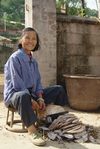

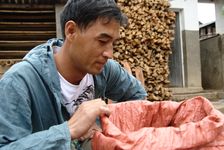
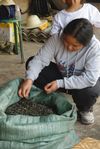
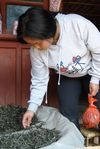

- 1. Small Mahei producer
- 2. Wang Bing observing a Maocha San Qiutian
- 4. Xiao Lee watching a Maocha to Mahei zhai
- 6. Small San Qiutian producer
Because you can never be content to trust a producer Maocha of the quality of the product before he leaves, and be sure to get quality sheets must constantly check each bag Maocha. Similarly, when the purchased material is not expected to be of quality, Wang will not hesitate to reject it, or keep it for production of lower quality in order to meet its customers' trust.
Because what matters most to Wang Bing is the confidence that our clients and give the respect that trust. Although theoretically compulsory sale of the finished product such as cakes, Wang Bing has also not the QS label, and do not worry about it for a moment. What is a label and what it provides? Wang Bing for the best and the only label on which to base his confidence is the quality of the tea. And if you want to see the gardens or working conditions and hygiene of his studio, and well just come to Wu Yi, the door is open.
Cakes and compression is in the same spirit. Compress a cake is indeed not very hard, do well and evenly against is less obvious. Again this is a great attention to detail but also the desire to do things well that makes Wang patties are so perfectly compressed, and look especially nice when both leaves are loosened under the peak makers.
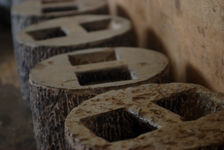
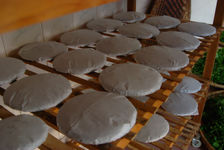
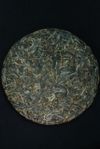
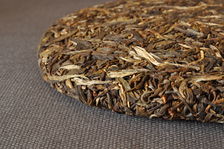
- 1. Stones used to compress puerh (Pu Er tea) cakes, in Wang Bing
- 2. Galette freshly compressed in the workshop Wang
- 3. Galette compressed by Wang Bing
Cha Gao, in search of ancestral tea
I will end this article on a specialty product that Wang Bing since 2010 and had to be reported: Cha Du Gao craft.
Among the gong ting, these teas superior products specifically for the emperor during the Qing Dynasty it y'avait indeed puerh (Pu Er tea) cakes, but also something much more brave again, a kind of concentrated nectar tea called Cha Gao . From much earlier times, where tea was not consumed in the form of sheets of dough but it is by making long simmer to concentrate the tea brew until something substantial that will be cool to be relatively strong. This kind of paste tea then dissolve in contact with water such as a instant tea.
Particularly brave the production of truth Cha Gao imperial requires a very large amount of leaves, but also a lot of patience and wood, the infusion should be heated more than a day without interruption in order to train Cha Gao.
Lost with the Cultural Revolution, the production techniques of the original Cha Gao interested for some time various producers Yi Wu, Liu Zhan example of Baopuxian which occurred in 2007 Cha Gao cake like the ancient tea cakes .
After a number of research and experimentation, inspired especially by other local customs like the production of soy sauce typical of Wu Yi, Wang completed in 2010 to build a small workshop for making this happen and Cha Gao his first year there Cha Gao traditional image of the past Gao Cha ...
 Chargement du thé...
Chargement du thé...Hoping that this little trip you like, you will be allowed for those who do not know Wang discovered that producer and teas, and others will ask you another look at these teas the next time you unpack a cake Wang Bing. I also invite you, now that you know a little about the family, watch again the video at the beginning of this article ... you'll probably see something else now.
Some photos Copyright Sebastian - vacuithe.blogspot.com
Video Copyright Pei-Shan Huang - www.puerh.fr

